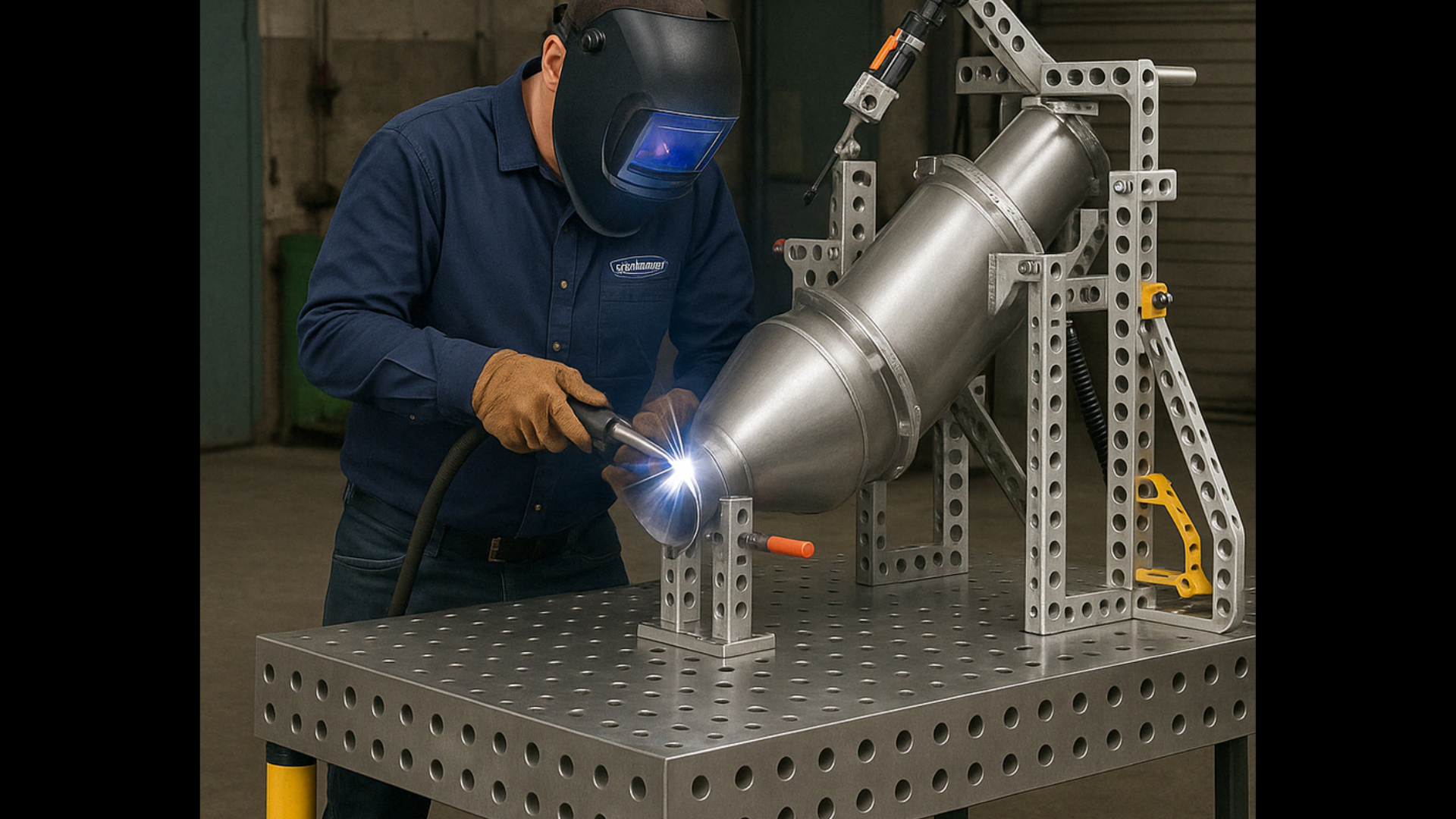
Welding is a cornerstone of modern fabrication – from automotive and aerospace to construction and metal furniture, it’s the process that brings metal parts together with strength and permanence. But not all welding is created equal. Each type of welding process comes with its own techniques, benefits, and ideal use cases.
At Carver Clamps, we’re proud to support welders with clamping and fixturing solutions that deliver speed, precision, and repeatability. Here we dive into the main types of welding, and how the right clamping system can make all the difference.
MIG Welding (Gas Metal Arc Welding – GMAW)
What it is: MIG welding uses a continuous solid wire electrode fed through a welding gun and into the weld pool. The weld area is protected by an inert gas, typically argon or a mix with CO₂.
Where it’s used: Common in automotive work, metal fabrication shops, and home workshops – MIG welding is known for its speed and ease of use, especially on thinner metals. MIG is fast, easy to learn, and ideal for high-throughput environments working with mild or stainless steel. It’s particularly well suited to thinner materials and repetitive welding tasks – which makes it perfect for production lines.
Where clamping matters: Holding parts firmly during fast, continuous welds is essential. Carver Clamps can be used to align panels, hold fixtures, and resist distortion from heat input.
TIG Welding (Gas Tungsten Arc Welding – GTAW)
What it is: TIG welding uses a non-consumable tungsten electrode and a separate filler rod. It’s slower than MIG but offers precision and control – producing clean, high-quality welds.
Where it’s used: TIG gives the welder precise control over heat and filler material, making it ideal for thin metals or detailed work. It also produces clean, spatter-free welds with no slag, meaning less finishing and a neater result. Aerospace, pressure vessels, bike frames, and artwork – TIG is preferred when appearance and accuracy matter most.
Where clamping matters: TIG welders often need both hands for the torch and filler, making solid, secure clamping essential. With Carver’s modular systems and welding tables, intricate setups become much easier to manage.
Stick Welding (Shielded Metal Arc Welding – SMAW)
What it is: This manual process uses a consumable electrode coated in flux to lay the weld. As it burns, the flux creates a shielding gas and slag to protect the weld.
Where it’s used: Stick welding works well in harsh environments, doesn’t require gas cylinders, and handles rusted or dirty metal with ease. It’s a rugged, go-anywhere welding method for tough jobs. It’s ideal for outdoor, structural, and repair work.
Where clamping matters: Even in rugged environments, having quick-to-set clamps can increase welding accuracy and reduce the need for rework.
Flux-Cored Arc Welding (FCAW)
What it is: Similar to MIG, but instead of a solid wire, it uses a tubular wire filled with flux. It can be used with or without shielding gas.
Where it’s used: FCAW delivers deep penetration and high deposition rates, making it ideal for thick materials and long welds. It also performs well in outdoor or drafty environments thanks to its flux shielding. Heavy-duty welding, such as in shipbuilding, pipelines, and heavy equipment – it’s ideal for thick materials and high-speed welds.
Where clamping matters: Large-scale jobs need robust, adjustable clamping. Carver’s heavy-duty clamps and accessories help maintain joint integrity across big setups.
Laser Welding & Robotic Welding
What it is: Laser welding uses a focused beam of light for extremely precise, high-speed welds. Robotic welding systems use automated arms for consistent output.
Where it’s used: These systems offer consistent, repeatable results with minimal distortion – perfect for industries where speed, consistency, and accuracy are vital. Laser welding also excels at micro-welding small or delicate parts. Therefore, high-tech industries like electronics, medical devices, and automotive manufacturing are best served by this welding type.
Where clamping matters: Robotic welding relies on precision positioning. Fixtures and clamps must be repeatable and accurate – making Carver’s repeat-clamp technology and modular tables a strong fit for automation-ready environments. Be sure to check out the Demmeler Cobot WeldSpace 4.0® for an automated welding solution.
Choosing the Right Tools for the Job
No matter the welding process, precision and consistency begin with secure, reliable workholding. Carver Clamps are designed to make welding setups faster, safer, and more repeatable – helping fabricators get the job done right the first time.
If you’d like help choosing the right clamping solution for your welding application, get in touch with our team or explore our full range of clamps, modular tables, and automation-ready systems.